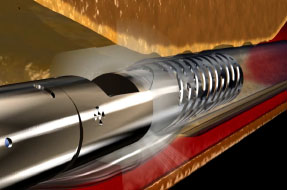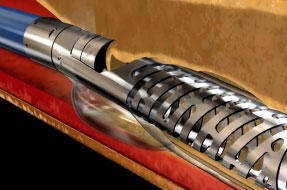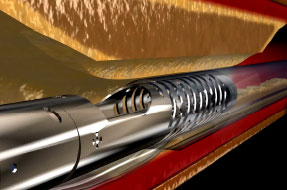A New Way to Treat PVD
Aug 9, 2016 |
 |
 |
| OCT fibers on the Pantheris device allows physicians to see the layer and blockage |
The torque shaft, cutter window, and apposition balloon prove the direction and precision to avoid disruption of layers |
The cutter and nosecone allow physicians to capture and remove the blockage |
Peripheral vascular disease (PVD) isn’t a disease that gets a lot of media coverage, even though it is one of the most common diseases of the arteries and affects millions of people a year. Also known as peripheral artery disease (PAD), PVD is any disease or disorder of the circulatory system not in the brain or heart. It’s most commonly seen in legs, though it can happen anywhere.
PVD is caused by the gradual build-up of fatty material inside the artery or vessel, and over time it can cause blockages. It occurs most commonly in people older than 60, and can be especially dangerous to those with diabetes.
“These blockages cause decreased circulation and pain, and can even lead to needing an amputation,” says Robert Heidepriem, MD, a vascular surgeon at Brookwood Baptist Medical Center.
Medication can help, but diagnosis often involves an arteriogram, a test that uses x-rays and dye to see inside of arteries, to identify a blockage. Procedures to fix the blockage, like a bypass, usually involve cutting all three arterial walls and an increased use of contrast and radiation.
However, technology advancements and training have brought a new option to patients – Pantheris, a less invasive procedure. Instead of having to do a bypass, which involves cutting the artery to remove the blockage, the Pantheris device is entered into the artery to remove the blockage internally. The new procedure is ultrasound guided, so physicians can see all three arterial walls, but with less contrast and radiation.
“This procedure allows us to preserve the artery and return blood flow, many times preventing amputation. It cuts down on radiation exposure for the patient and surgeon, has less renal failure, and now we don’t have to cut open the artery to remove the blockage,” says Heidepriem, one of only a few physicians in Alabama currently trained to use this technology.
Heidepriem tells us this procedure is perfect for patients that have renal dysfunction and can’t have a lot of dye, or patients that can’t have major surgery due to the risk of sedation. The procedure is less invasive, can be done under local sedation and may eliminate the need for a hospital stay.
“We want to help people save their legs, and this procedure means we may be able to save legs from amputation. It used to be that if a bypass didn’t work, your only other option was amputation, but this procedure can change that.”
If you would like to make an appointment with Dr. Robert Heidepriem or another BBH vascular physician, please find a physician near you by clicking here or calling 855-830-9731.
